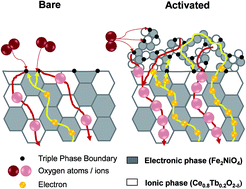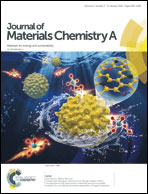Enhancing oxygen permeation through Fe2NiO4–Ce0.8Tb0.2O2−δ composite membranes using porous layers activated with Pr6O11 nanoparticles†
Abstract
Fe2NiO4–Ce0.8Tb0.2O2−δ (NFO–CTO) composite membranes are of interest to separate oxygen from air. In this study, we investigate the influence of the catalytic activation of NFO–CTO membranes on the oxygen permeation rate. Specifically, the effect of activating porous NFO–CTO layers –coated on both sides of the dense NFO–CTO membrane – with Pr6O11 nanoparticles is studied. Measurements in the temperature range 850–700 °C revealed a 2–4 fold increase in the oxygen flux after coating a 30 μm-thick porous NFO–CTO layer on both membrane sides, and a 6–12 fold increase relative to the bare membrane after activating the porous layers coated on both sides of the membrane with Pr6O11 nanoparticles. No degradation of the oxygen fluxes was found in CO2-containing atmospheres. Pulse isotopic exchange measurements confirmed an increase in the oxygen surface exchange rate of more than one order of magnitude after dispersion of Pr6O11 nanoparticles on the surface of NFO–CTO composite powders. Electrochemical impedance spectroscopy measurements on symmetrical cells, using Gd-doped ceria (CGO) as the electrolyte and Pr6O11-activated NFO–CTO electrodes, showed a 10-fold decrease in the polarization resistance compared to non-infiltrated electrodes in air. Modification of porous layers by activation with Pr6O11 nanoparticles is considered a viable route to enhance the oxygen fluxes across composite membranes.



 Please wait while we load your content...
Please wait while we load your content...